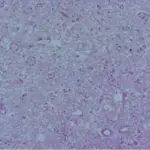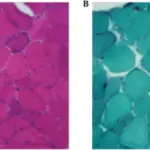Mitochondrial encephalomyopathy lactic acidosis and stroke-like episodes (MELAS) is an extremely rare genetic condition that begins in childhood. The disorder affects many areas of the body, especially the brain and nervous system. MELAS is also characterized by a buildup of lactic acid in the body as well as stroke-like symptoms, such as temporary muscle weakness.
What is the Pathology of Mitochondrial Encephalomyopathy Lactic Acidosis and Stroke-Like Episodes (MELAS)?
MELAS is a mitochondrial disease.
Etiology: MELAS is caused by mutations in mitochondrial DNA (mtDNA).
Genes involved: Mutations affecting the genes for mtDNA are inherited from the mother. MT-TL1, in MT-TQ, MT-TH, MT-TK, MT-TS1, MT-ND1, MT-ND5, MT-ND6, and MT-TS2.
Pathogenesis: Defective mitochondria.
Histology: The histology associated with Mitochondrial encephalomyopathy lactic acidosis and stroke-like episodes (MELAS) shows diseased mitochondria proliferation in an attempt to compensate for poor energy production. They appear bright red compared to the blue myofibers, therefore called ragged red fibers.
How does Mitochondrial Encephalomyopathy Lactic Acidosis and Stroke-Like Episodes (MELAS) Present?
Patients with Mitochondrial encephalomyopathy lactic acidosis and stroke-like episodes (MELAS) typically are both males and females equally. The disease begins in childhood between 2-15 years of age. The symptoms, features, and clinical findings associated with Mitochondrial encephalomyopathy lactic acidosis and stroke-like episodes (MELAS) include seizures, headaches, hearing issues, ataxia, and myoclonus.
How is Mitochondrial Encephalomyopathy Lactic Acidosis and Stroke-Like Episodes (MELAS) Diagnosed?
Mitochondrial encephalomyopathy lactic acidosis and stroke-like episodes (MELAS) is diagnosed based on clinical findings and molecular genetic testing. Muscle biopsy may show ragged red fibers.
How is Mitochondrial Encephalomyopathy Lactic Acidosis and Stroke-Like Episodes (MELAS) Treated?
Mitochondrial encephalomyopathy lactic acidosis and stroke-like episodes (MELAS) has no specific treatment. Anticonvulsant medications may help with seizures.
What is the Prognosis of Mitochondrial Encephalomyopathy Lactic Acidosis and Stroke-Like Episodes (MELAS)?
The prognosis of Mitochondrial encephalomyopathy lactic acidosis and stroke-like episodes (MELAS) is poor.



